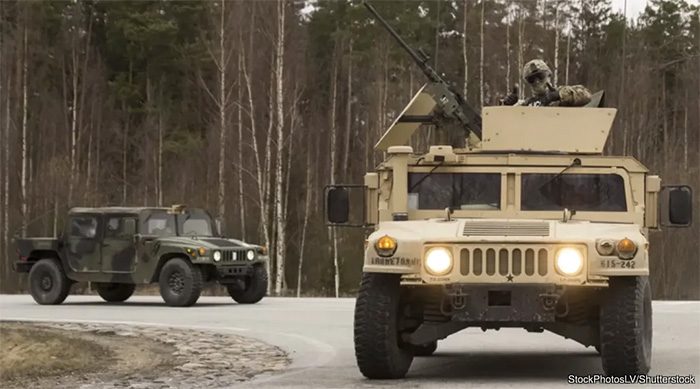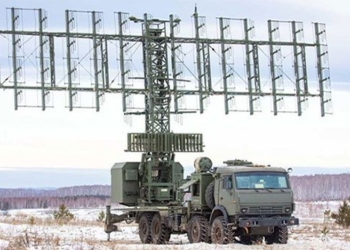Over the past 30 years, the HMMWV (High Mobility Multipurpose Wheeled Vehicle), commonly known as the “Humvee,” has become an iconic vehicle both on the battlefield and in military transport operations. From Operation Desert Storm to the conflict in Ukraine, the Humvee has been utilized in nearly every conflict around the world since 1989.
Almost every modern armed force in the U.S., whether local police departments or Navy SEALs, has at least once been aboard this type of vehicle.
In fact, the Humvee is so prevalent that if you happen to visit the U.S., don’t be surprised to see an old Humvee parked in front of a grocery store or cruising around town. According to the manufacturer AM General, this vehicle has been exported to over 70 countries worldwide.
By 2022, the U.S. military began replacing the Humvee with the Oshkosh J-LTV (Joint-Light Tactical Vehicle). Nevertheless, it is hard to forget the immeasurable impact the Humvee has had on the battlefield, in popular culture, and in the automotive industry. It has appeared in numerous films, video games, and even served as the predecessor to an entirely new line of SUVs – including an electric model – known as the Hummer.
Have you ever wondered how the Humvee achieved all of this? Much like the Jeep, the story of the Humvee began in fierce battles.
 Humvee is an iconic vehicle both on the battlefield and in military transport operations.
Humvee is an iconic vehicle both on the battlefield and in military transport operations.
After the defeat in the Vietnam War, the Pentagon decided to replace the Jeep fleet that had served in the military for several decades. In 1983, the U.S. government signed a $1 billion contract with AM General, a company initially focused on producing mail vehicles, heavy trucks, and other military vehicles under the management of American Motors, which was later acquired by LTV Aerospace and Defense. The U.S. military wanted a multipurpose vehicle: capable of fording streams, traversing rugged terrain, safely transporting troops and supplies, and also serving as a weapons platform for offensive operations.
HMMWV M998 was the first model introduced, but soldiers preferred to call it by the names “Humvee” and “Hummer” that we are familiar with today. This vehicle saw brief combat during the U.S. invasion of Panama in 1989 and then became an indispensable part of Operation Desert Storm against Saddam Hussein’s regime. It was used by coalition forces as a launching platform for TOW anti-tank missiles, Browning M2 heavy machine guns, and M240 machine guns.
The latest version of the Humvee, the HMMWV M1167, features a turbocharged V8 diesel engine and a modular design that allows for the addition of various weapons, armor, medical equipment, or reconnaissance gear.
In the early 1990s, Arnold Schwarzenegger spotted a Humvee and immediately fell in love with the vehicle. In 1992, the first civilian model, the Hummer H1, hit the market. Hummer became a phenomenon in popular culture with the Hummer H2, a prime example of the best and the… worst of the American automotive industry. Civilian Hummer models are large and rugged, remaining popular nearly 20 years after the first H2s rolled off the assembly line.
 Humvee was originally designed to be modular and easily customizable.
Humvee was originally designed to be modular and easily customizable.
As the U.S. engaged in the War on Terror and invaded Iraq, the Humvee revealed shortcomings that showed it was not fully prepared for asymmetric warfare. This vehicle excelled in confrontations with traditional forces, as seen in Operation Desert Storm; however, the situation was entirely different when operating in the crowded streets of Baghdad and Fallujah. The Humvee became a hot target for ambushes and countless surprise bombings from enemy forces. Ultimately, the U.S. military had to deploy newer models of Humvees with enhanced armor.
From the beginning, the Humvee was designed to be modular and easily customizable, allowing these enhanced armored versions to thrive on the front lines. Light armored models were used as ambulances or troop transporters. The Humvee became a legend, as it could operate anywhere, in any manner the operator desired.
 In the U.S., many local police departments use Humvees in their daily operations.
In the U.S., many local police departments use Humvees in their daily operations.
Even terrorist organizations like the Taliban and ISIS have used stolen or abandoned Humvees in combat. In military operations against ISIS, Humvees were even modified into bomb-carrying vehicles. Currently, Ukrainian forces are using U.S.-supplied Humvees in their counter-offensive operations. It can be said that wherever there is a battlefield, there is a Humvee.
Across the United States, many local police departments use Humvees in their daily operations. Civilians can also easily acquire used Humvees or military surplus vehicles that are no longer needed. With over 300,000 Humvees produced and exported worldwide, replacement parts can be found everywhere. A vehicle designed for combat is certainly a perfect candidate for off-road adventures!
Over the decades, the Humvee has continuously appeared in conflict zones around the globe. Although the U.S. is gradually phasing out the Humvee, this famous military truck will likely continue to be in demand in many other parts of the world for at least a few more decades.




















































